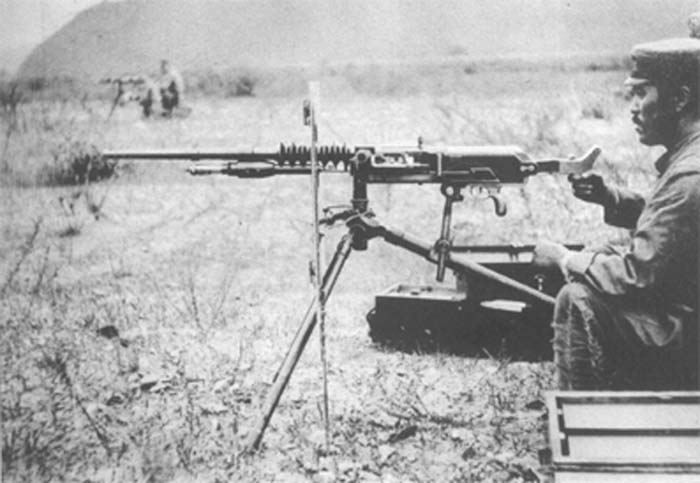
French Machine Gun Type Ho
The first Hotchkiss machine guns manufactured in France, the Model 1897, were acquired by the Imperial Japanese Army in 1898 and intended for evaluation. Japanese sources indicate they were chambered for the new 6.5x51SR Arisaka Type 30 cartridge. Only a handful were ordered and all feed strips must have been standard French types imported from France with the guns. These trials must have been successful as the first Hotchkiss guns imported in large quantity and used in combat were purchased beginning in 1902. According to Imperial Japanese Army acquisition records, they were a version of the Model 1900 Hotchkiss made to Imperial Japanese Army requirements. Besides the caliber (6.5x51SR Arisaka Type 30), they differed from other contemporary Hotchkiss guns in having two additional cooling rings on the barrel (seven instead of the usual five). The Imperial Japanese Army designation for these weapons was Type Ho: using a kanji for Ho. The use of the abbreviation instead of an adoption year indicates a foreign-made gun. Type Ho weapons were the only Hotchkiss guns used by Japan in the Russo-Japanese war (1904-1905). The latest document mentioning them found in a brief scan of the Japanese National Archives is dated 1907, so they appear to have passed quickly out of service on adoption of the Type 38. It is quite possible they were converted to the Type 38 standard.
These French-made weapons were fed with 30-round rigid brass strips. Each loaded rigid strip was individually packed in a cardboard sleeve, which protected the strip while being transported in the ammunition crate. It was only during the feeding of the strip into the weapon that the cardboard sleeve was removed.
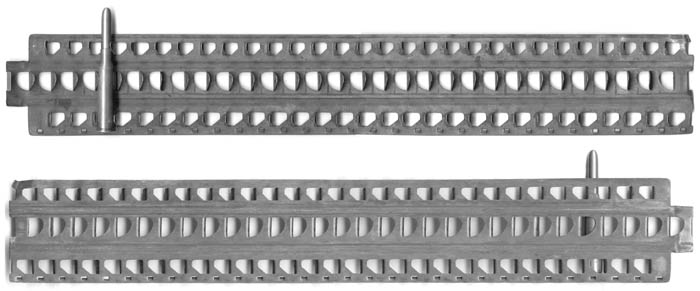
The French brass strips offered for export during the very first years after 1900 are marked with a tiny letter within a shield. The exact meaning of this marking (inspection or manufacturer stamp) remains unknown. It is also possible that some strips for the Type Ho guns were made in Japan, but if so, they would probably have been made on imported French machinery and be indistinguishable from French strips except perhaps for this marking. So far, the author has been unable to unequivocally identify any Japanese-made strips for Type Ho weapons.
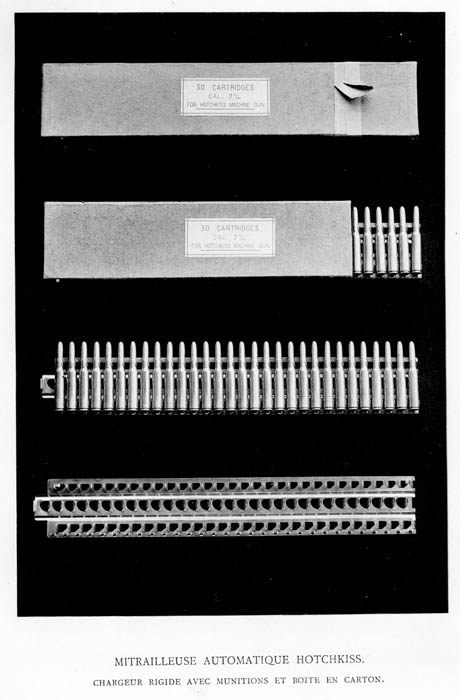
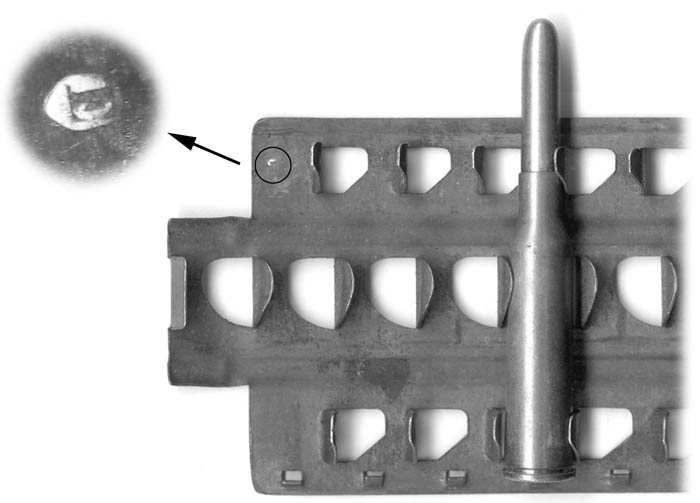
Japanese Machine Gun Type 38
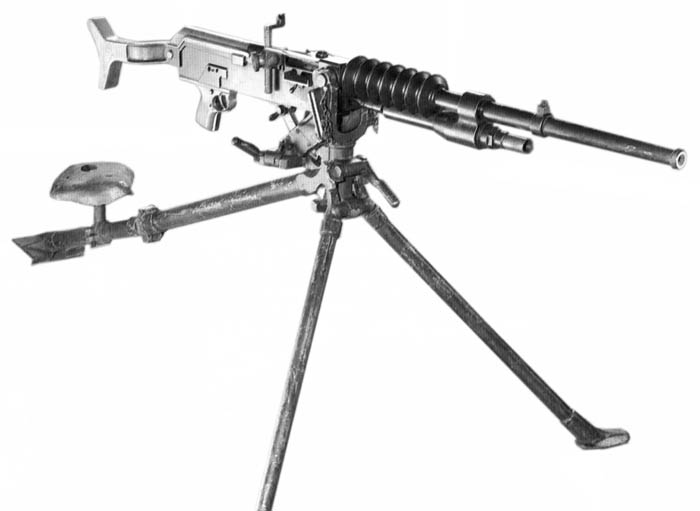
When the Imperial Japanese Army purchased the French-made Type Ho, they also bought a license to manufacture it. The first Japanese-made gun, manufactured under Hotchkiss license, was adopted under the designation Type 38; the Japanese equivalent of Model 1905 (38th year of the Meiji era = 1905). Despite this designation, these guns only began to reach service in 1906. Also, despite a designation indicating Japanese manufacture, it is very likely that some major components, especially barrels, and possibly whole guns, were still made in France, at least at first. There probably was considerable parts interchangeability with the Type Ho.
The Type 38 was not an exact copy of the Type Ho as the Japanese never exactly copied a foreign design. In this case, they added a cartridge oiler to the feedway, and a new trigger group and pistol grip, including a grip catch that held the trigger for continuous fire. Type 38 guns were in service at least as late as 1940, according to documents in the Japanese National Archives. However, from about 1935, they were second-line guns, serving as trainers with special blank-firing barrels and as home-defense anti-aircraft guns. In the early 1930s, many were decommissioned and sold to China, only to be used against Japan later.

The Type 38 continued to use the same 30-round brass strips, but no cardboard sleeve specifically marked for it has been found for this article. It is likely that, at least at first, strips for it were made on French machinery.
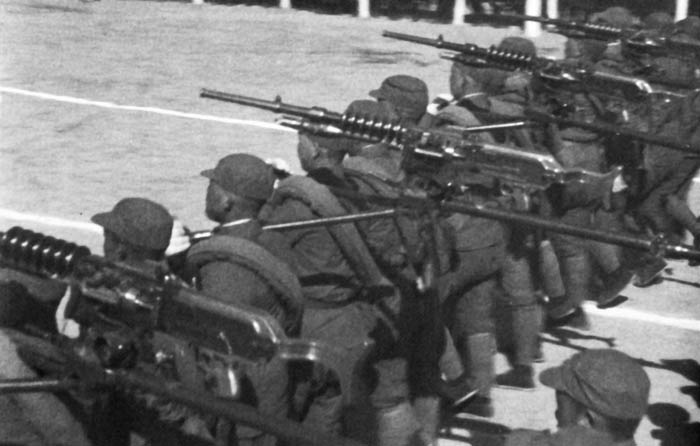
The Japanese army, under the approval of their Military Provisional Committee, ordered from France samples of Model 1909 Portative light machine guns in original 8mm French caliber for research with aircraft in 1915. These weapons were referred to as the Type 42. Experiments were carried out with the Type MO aircraft at the army’s Tokorozawa Airfield facility.
Japanese Machine Gun Type 3
The first machine gun truly of Japanese design chambered for the 6.5x51SR Arisaka cartridge was the Year 3 Type, usually referred to in English as simply Type 3. The kanji character for “year” was included in the formal Japanese designation to indicate that the 3 represents the 3rd year of the reign of the Emperor Taisho, i.e., 1914 in the Gregorian calendar. This gun was the work of the famous designer Kijiro Nambu, and is mechanically very different from the Hotchkiss. It used only two Hotchkiss features: the feed wheel/feed strip and the Hotchkiss-style operating rod (although the exact form of the operating rod was different). These guns entered service in the World War I period, with both the Army and Navy, and remained in service through the Pacific War in late World War II mainly with Japanese troops in China.
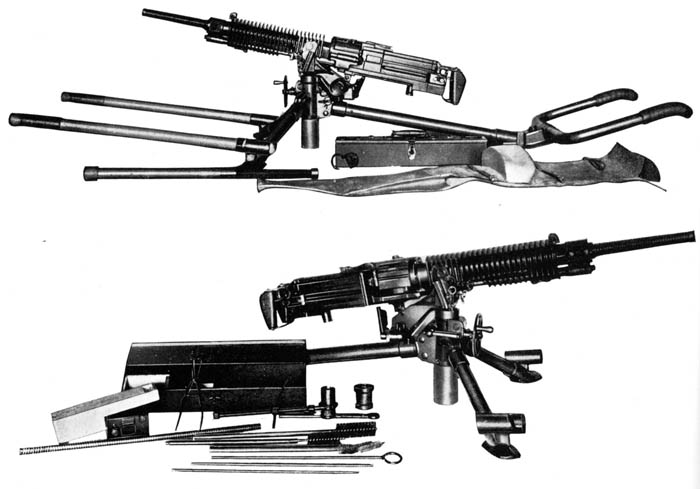
The 30-round feed strips for this gun are almost identical to the early French brass export models and retain the cardboard protecting sleeve. The Japanese cardboard sleeves are usually covered with a kind of gauze. Although no official document has been found concerning this issue, various reasons have been suggested by different knowledgeable authors. It is probable that the reason for the gauze covering could be found among the following various explanations: to prevent moisture deterioration; to add strength to the container; to prevent damage from the pointed bullets during handling and to improve the grip on the sleeve in order to facilitate its manipulation.
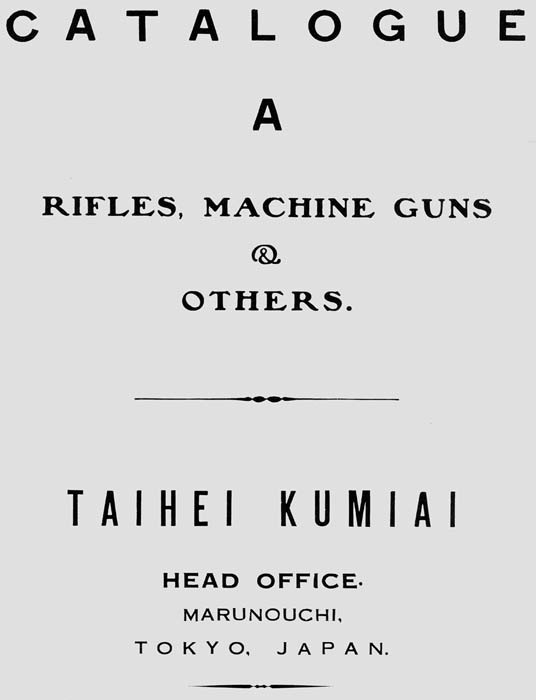
The cardboard sleeve containing a single loaded strip bears a label describing the content of the sleeve. Usually, a second little label, glued on the side of the sleeve, states the type of ammunition as well as the manufacturing data (lot numbers and date of production). Ammunition and feed strips for Type 3 weapons have also been manufactured in the independent state of Manchukuo (Manchuria). This state, geographically situated in continental China, gained independence from China in 1932 after the invasion of the Japanese army in 1931. In 1934, Pu Yi was declared Emperor of the Manchukuo Empire, which although theoretically an independent state was in fact closely controlled by the Japanese. Production occurred in the city named Mukden (in Manchu spelling) within the Hoten Zoheisho Kabaushiki Kaisha (Hoten Arsenal Co. Ltd.) established at the old Three Provinces Arsenal site in November 1932 after Japanese occupation in 1931. This facility is also commonly referred to as simply Mukden Arsenal.
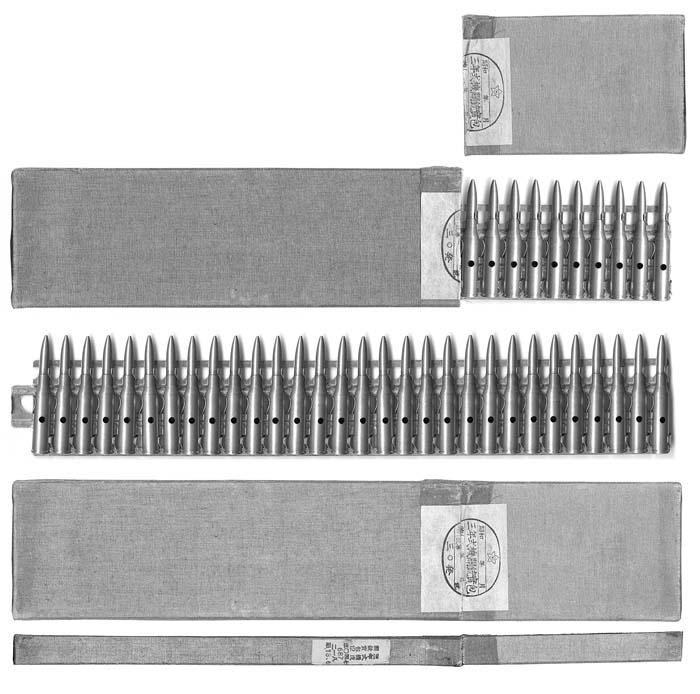
In the 1920s, Type 3 machine guns chambered for 7×57 Mauser were adopted by Chile under the designation Modelo 1920. Probably only a few hundreds of weapons manufactured at the Kokura Arsenal were imported from Japan. However, it seems that the barrels, the main specific part for the 7mm caliber, were imported from the Hotchkiss Company in France. Accordingly, the Chilean Modelo 1920 weapons observed so far bear the Japanese Kokura logo on the receiver and the French Hotchkiss logo on the barrel.
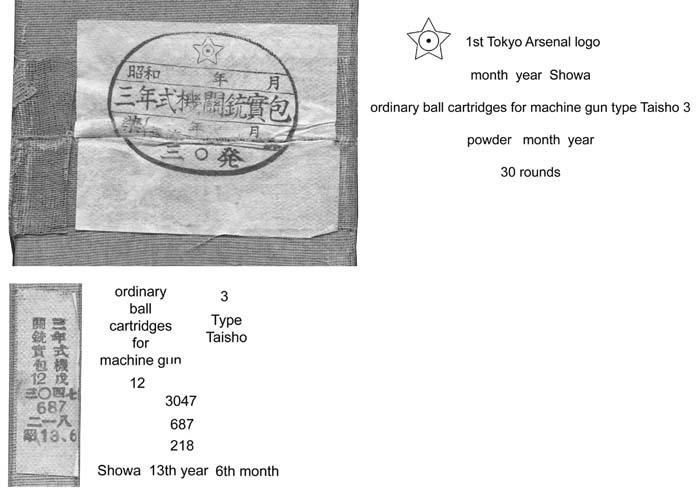
The Chilean-made strips for the Modelo 1920 are similar to the early French Hotchkiss strips and therefore differ from the contemporary Japanese strips for Type 3 by the lack of the corner notch. These 30-round brass strips are marked with a shield containing the indication of the manufacturer FAMAE (Fabricas y Maestranzas el Ejercito in Santiago) as well as “CHILE”.
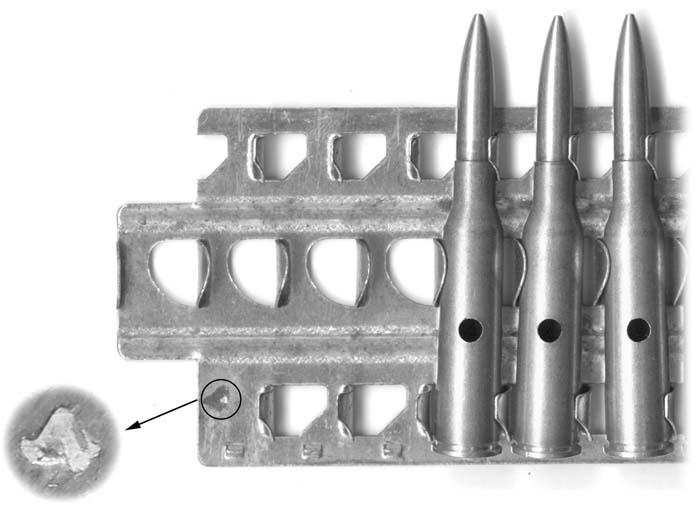
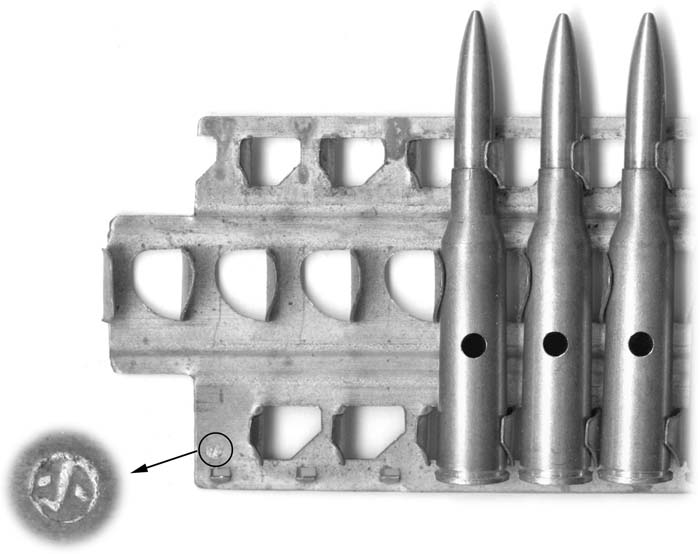
Japanese Machine Gun Type 92

From 1932 onwards, an updated version of the Type 3 machine gun entered service under the designation Type 92 therewith indicating its year of adoption (2592 in the Jimmu calendar – the beginning of which corresponds to the mythical creation of the Japanese Empire, 660 BC in the Gregorian calendar). Type 92 machine guns are chambered for the more powerful 7.7x58SR ammunition and remain fed with 30-round rigid strips. Many Type 3 guns were converted to the Type 92 standard.
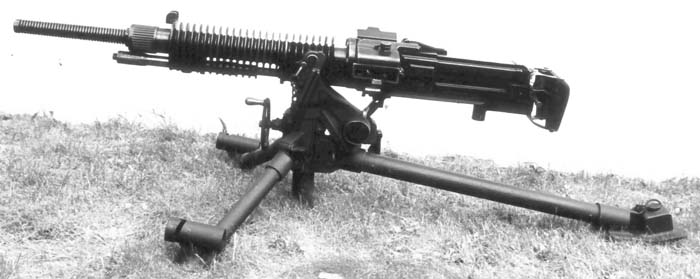
The geometry of the 7.7mm strips is identical to that for 6.5mm. Shooters have found that strips originally loaded with 7.7mm cartridges can be reloaded with 6.5mm and function perfectly and vice versa. From approximately 1943 onwards, the brass strips were often replaced by tinned or zinc-washed steel strips of identical geometry. The individual cardboard sleeves are simplified and do not bear the external gauze anymore. The sealing of the two parts of the sleeve remains done with a label, which indicates the contents of the sleeve. The data concerning the lot numbers and date of production are no longer printed on an extra label but are directly inked on the side of the sleeve. The Japanese strips for both for 6.5 and 7.7mm bear, almost always in the same place, a small character, the meaning of which remains unknown (manufacturer code or inspection mark).
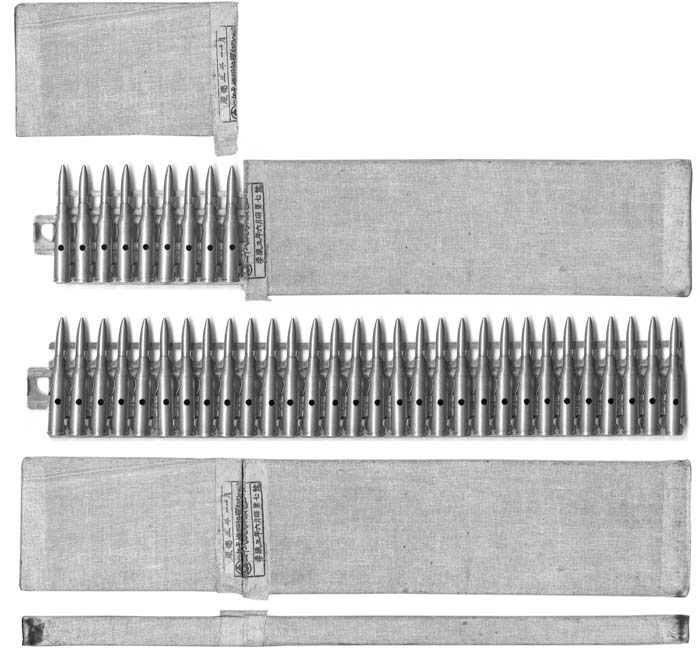
It is worth noting that, whereas the design of the rigid strips used by the Hotchkiss company was improved several times between 1900 and 1930, the Japanese strips remained faithful to the original French design of 1897. The majority of the evolutions designed by the Hotchkiss company in France were intended to increase the longevity of the strips. Those strips were supposed to be reloaded a great number of times and therefore, a special recalibrating tool was provided with the weapon’s accessories.
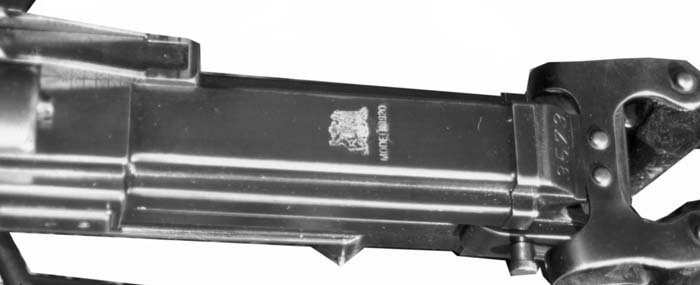
The major evolutions of the Hotchkiss commercial strips concerned both the stamping pattern of the hooks to fasten the cartridges and the characteristics of the metal sheet used (brass, various heat-treated steels, different thicknesses, etc.). On the other side, the Japanese strips never incorporated any of those major evolutions. This might be explained by the fact that the Japanese strips were considered as consumable and not as a weapon accessory. Indeed, the Japanese strips, even in new unissued condition, appear particularly fragile as the brass sheet is not very rigid and the hooks retaining the cartridges can be easily bent or broken. In most cases, a single feeding through the weapon represents the maximum that a strip can withstand.
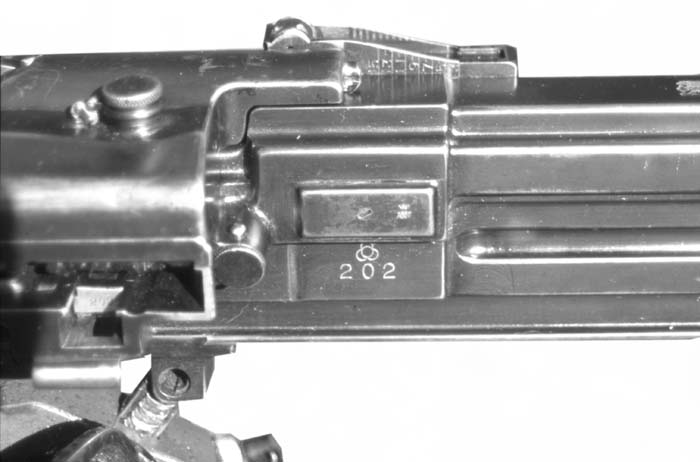
For field combat use, the strips, fitted in their cardboard sleeves, were carried in two different models of chests. For infantry units, 18 strips were packed in a chest Model A, which could be carried on a man’s back by means of straps. For cavalry units, a larger chest of Model B carried 25 strips. The shipping crate was of the same dimensions as the Model A, but much cruder and not back-packable. It held 25 strips because they were packed into it differently.
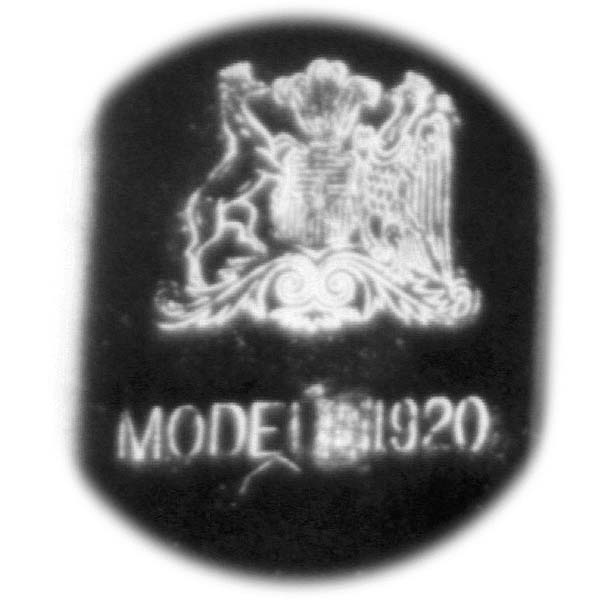
(The author acknowledges the help of Mr. Ted Bradstreet and Dr. Edwin Libby for their key contribution to enlighten the historical background of the early Imperial Japanese Army machine guns and to Mr. William M.P. Easterly for his thorough review of the manuscript.)

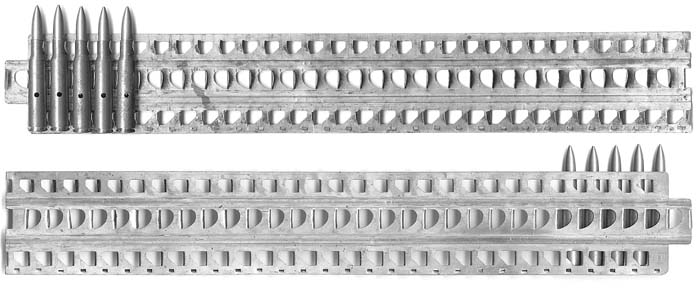
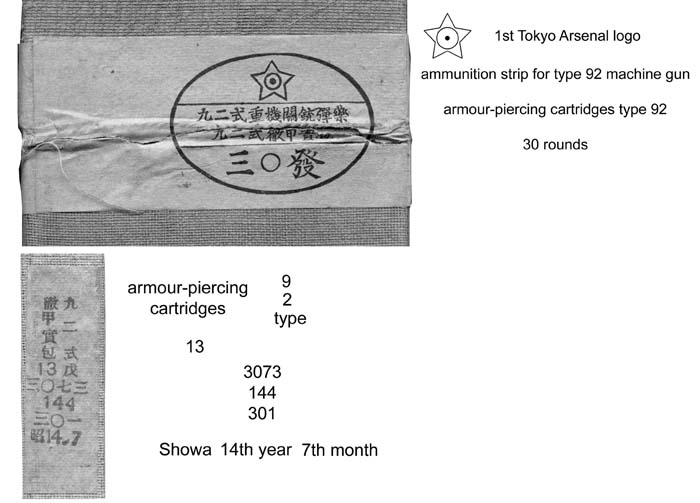
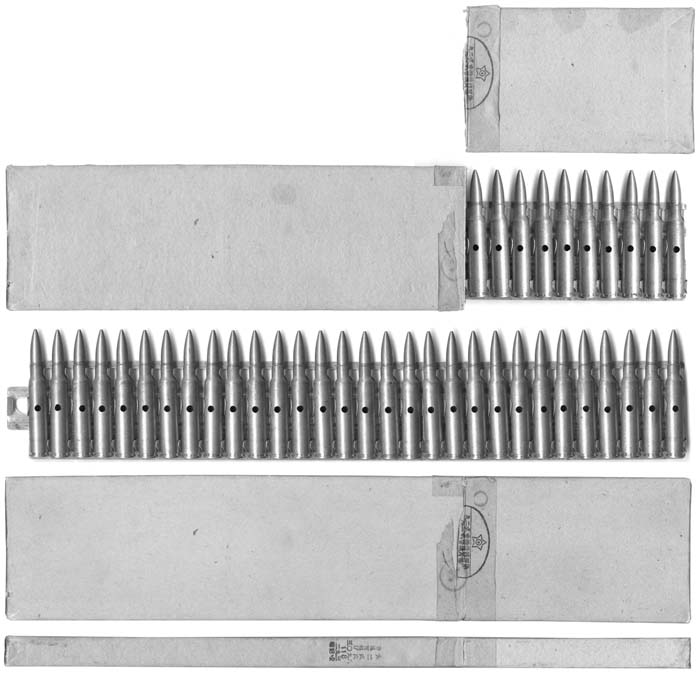
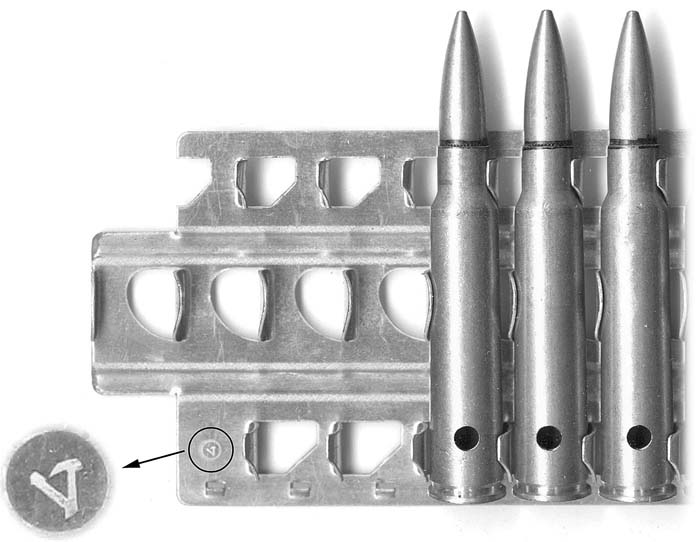
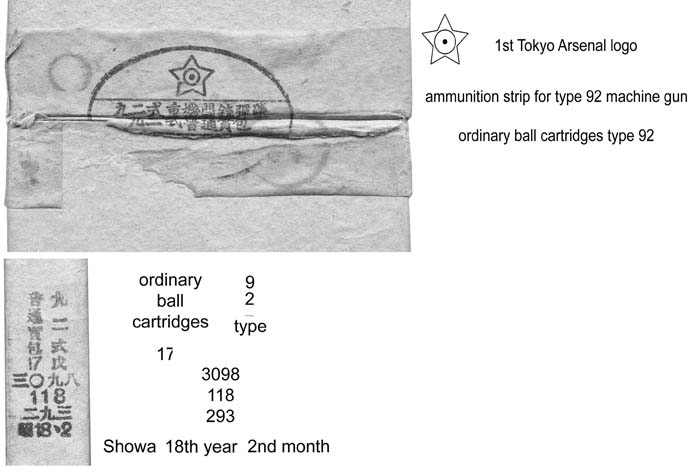
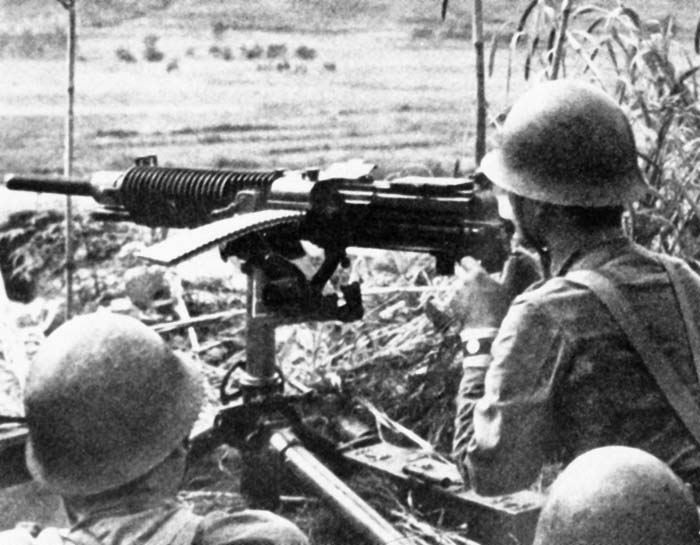
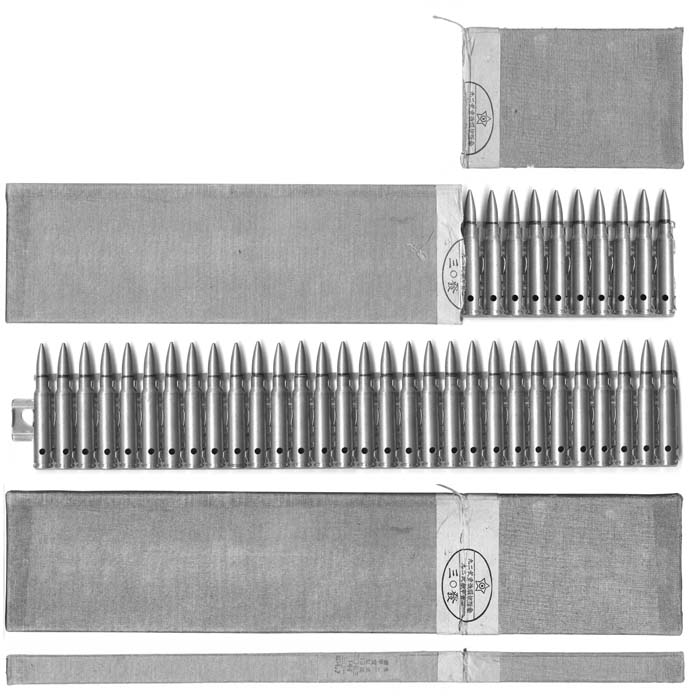
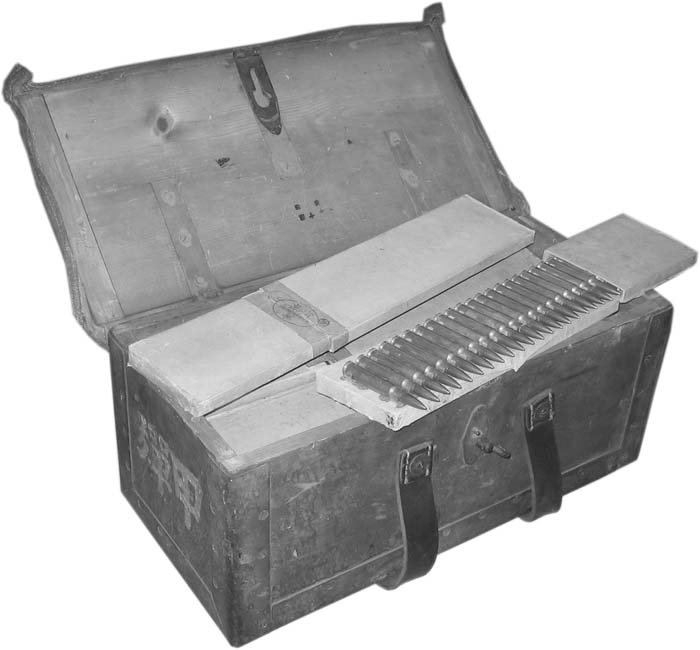
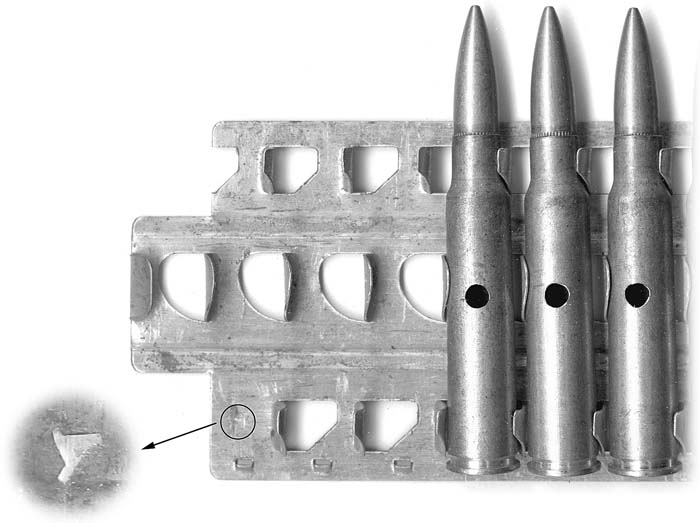
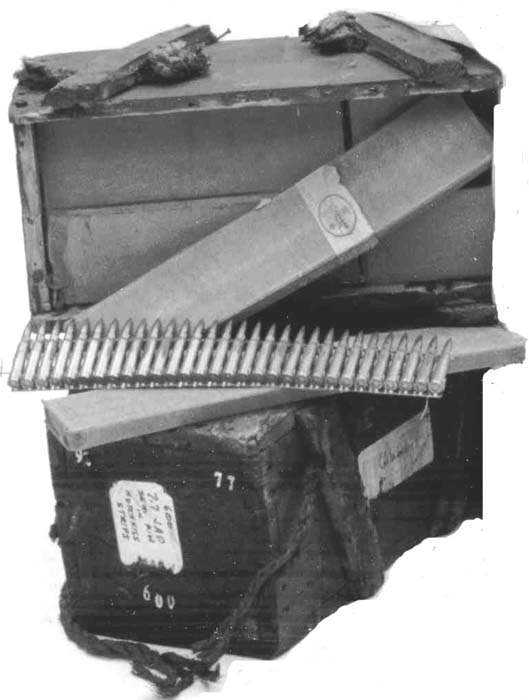
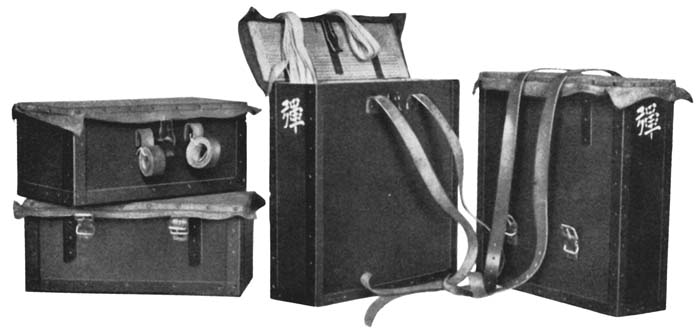
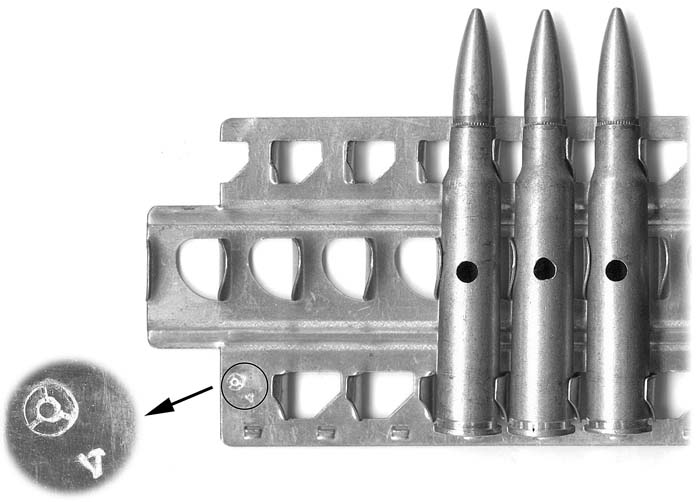
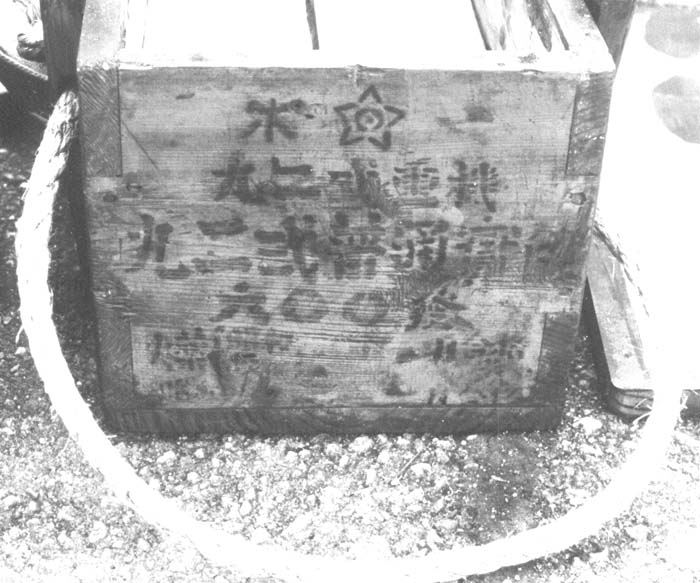
| This article first appeared in Small Arms Review V12N10 (July 2009) |











